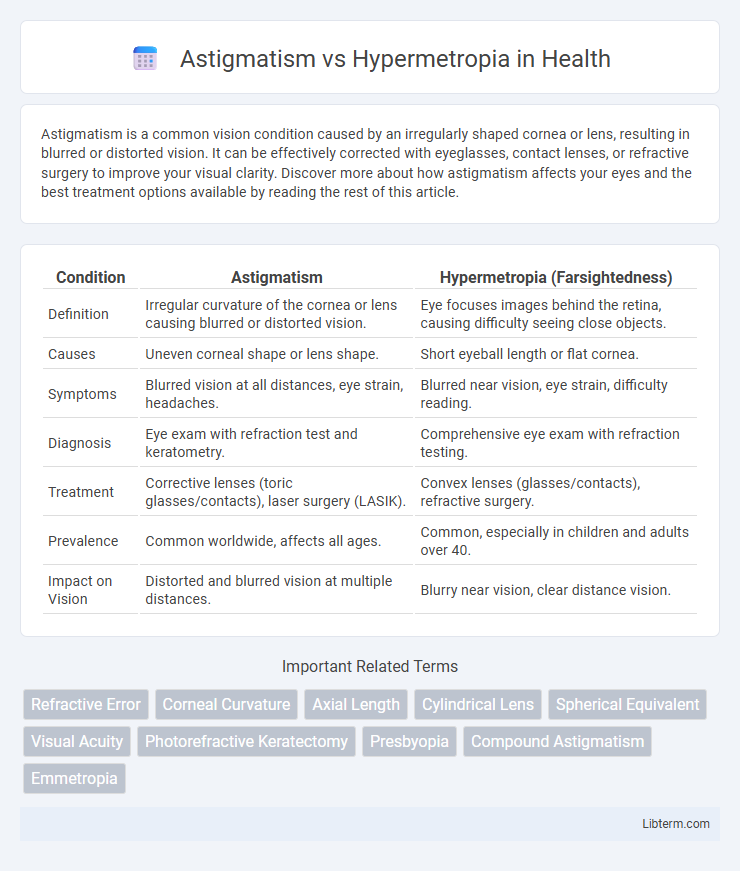Astigmatism is a common vision condition caused by an irregularly shaped cornea or lens, resulting in blurred or distorted vision. It can be effectively corrected with eyeglasses, contact lenses, or refractive surgery to improve your visual clarity. Discover more about how astigmatism affects your eyes and the best treatment options available by reading the rest of this article.
Table of Comparison
| Condition | Astigmatism | Hypermetropia (Farsightedness) |
|---|---|---|
| Definition | Irregular curvature of the cornea or lens causing blurred or distorted vision. | Eye focuses images behind the retina, causing difficulty seeing close objects. |
| Causes | Uneven corneal shape or lens shape. | Short eyeball length or flat cornea. |
| Symptoms | Blurred vision at all distances, eye strain, headaches. | Blurred near vision, eye strain, difficulty reading. |
| Diagnosis | Eye exam with refraction test and keratometry. | Comprehensive eye exam with refraction testing. |
| Treatment | Corrective lenses (toric glasses/contacts), laser surgery (LASIK). | Convex lenses (glasses/contacts), refractive surgery. |
| Prevalence | Common worldwide, affects all ages. | Common, especially in children and adults over 40. |
| Impact on Vision | Distorted and blurred vision at multiple distances. | Blurry near vision, clear distance vision. |
Understanding Astigmatism and Hypermetropia
Astigmatism is a common refractive error caused by an irregularly shaped cornea or lens, leading to blurred or distorted vision at all distances. Hypermetropia, also known as farsightedness, occurs when the eyeball is too short or the cornea has insufficient curvature, causing difficulty focusing on close objects. Both conditions affect visual clarity but require different corrective measures such as specially designed glasses, contact lenses, or laser surgery to improve vision quality.
Causes of Astigmatism vs Hypermetropia
Astigmatism is caused by an irregularly shaped cornea or lens that prevents light from focusing properly on the retina, leading to blurred or distorted vision. Hypermetropia, or farsightedness, results from a shorter eyeball or a flat cornea that causes light to focus behind the retina, making nearby objects appear blurry. Both conditions involve refractive errors but differ fundamentally in the anatomical abnormalities affecting light refraction.
Symptoms Comparison: Astigmatism vs Hypermetropia
Astigmatism causes blurred or distorted vision at all distances due to irregular curvature of the cornea or lens, often accompanied by headaches and eye strain. Hypermetropia, or farsightedness, results in difficulty focusing on close objects, causing eye fatigue and occasional blurred near vision, especially in children and older adults. Both conditions can lead to squinting and discomfort but differ primarily in the type and range of visual impairment experienced.
How Astigmatism Affects Vision
Astigmatism causes blurred or distorted vision due to an irregularly shaped cornea or lens, which prevents light from focusing evenly on the retina. This results in difficulty seeing fine details at both near and far distances, often producing ghosting or double images. Unlike hypermetropia, where distant objects are clear and close objects are blurry, astigmatism affects vision clarity across all distances.
How Hypermetropia Affects Vision
Hypermetropia, or farsightedness, causes distant objects to appear clearer while nearby objects seem blurry due to the eye's inability to focus light directly on the retina. The eye's shortened axial length or flattened cornea leads to light focusing behind the retina, resulting in strain and headaches during close-up tasks. Unlike astigmatism, which distorts vision at all distances due to irregular corneal curvature, hypermetropia specifically impairs near vision.
Diagnostic Methods for Both Conditions
Astigmatism diagnosis primarily involves corneal topography and keratometry, which map the cornea's curvature to detect irregularities causing distorted vision. Hypermetropia diagnosis relies on retinoscopy and autorefractor assessments that measure the eye's refractive error, often confirmed through a detailed eye examination with cycloplegic refraction. Both conditions may require slit-lamp biomicroscopy to exclude associated ocular abnormalities for accurate diagnosis and treatment planning.
Treatment Options: Astigmatism vs Hypermetropia
Treatment options for astigmatism primarily include corrective lenses such as toric contact lenses or specially designed eyeglasses that compensate for the irregular corneal shape. Hypermetropia is commonly treated with convex lenses that help focus light correctly onto the retina, enhancing distant vision. Refractive surgeries like LASIK or PRK can be effective for both conditions by reshaping the cornea to improve light refraction.
Eyeglasses and Contact Lenses Differences
Astigmatism requires eyeglasses or contact lenses with cylindrical lenses that correct irregular corneal curvature, while hypermetropia (farsightedness) is corrected with convex lenses to focus images properly on the retina. Contact lenses for astigmatism are often toric, designed to maintain orientation on the eye, whereas hypermetropic lenses are typically spherical, focusing light more uniformly. Both conditions demand precise prescription measurements, but the specialized design of toric lenses for astigmatism differentiates them significantly from the standard lenses used for hypermetropia.
Lifestyle Adjustments for Each Condition
Astigmatism requires lifestyle adjustments such as using corrective lenses with cylindrical prescriptions and avoiding prolonged screen time to reduce eye strain. Hypermetropia demands regular use of convex lenses and maintaining proper reading distances to prevent headaches and eye fatigue. Both conditions benefit from routine eye check-ups and ergonomic workspace setups to support visual comfort and clarity.
Prevention and Eye Care Tips
Astigmatism can be managed through regular eye check-ups and wearing prescribed corrective lenses like toric contact lenses or glasses to prevent worsening vision. Hypermetropia prevention emphasizes protecting eyes from strain by practicing the 20-20-20 rule and ensuring proper lighting during reading or screen time. Maintaining a balanced diet rich in vitamins A, C, and E supports overall eye health and may reduce the progression of refractive errors.
Astigmatism Infographic

 libterm.com
libterm.com